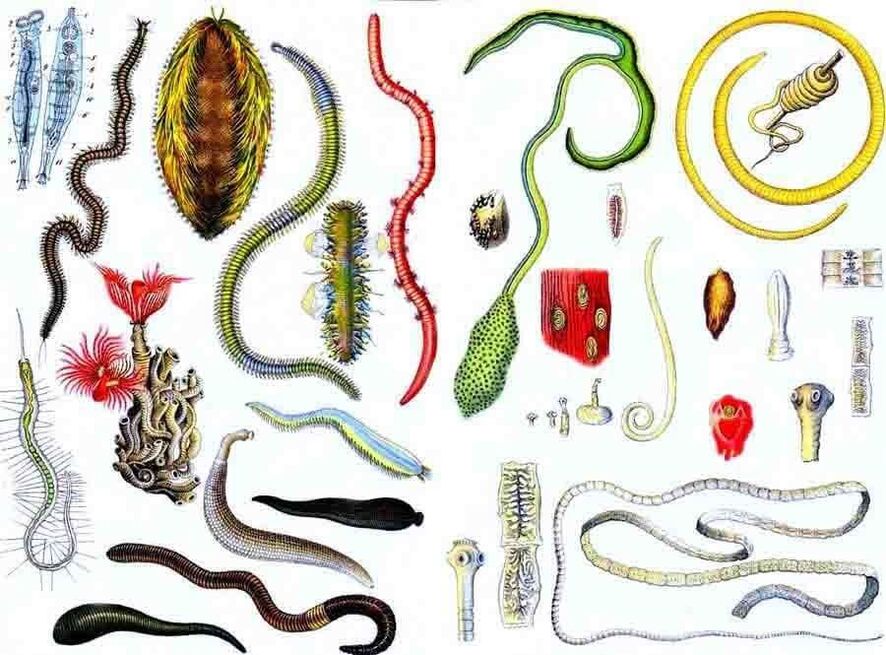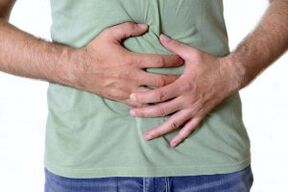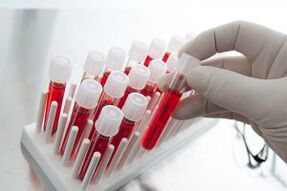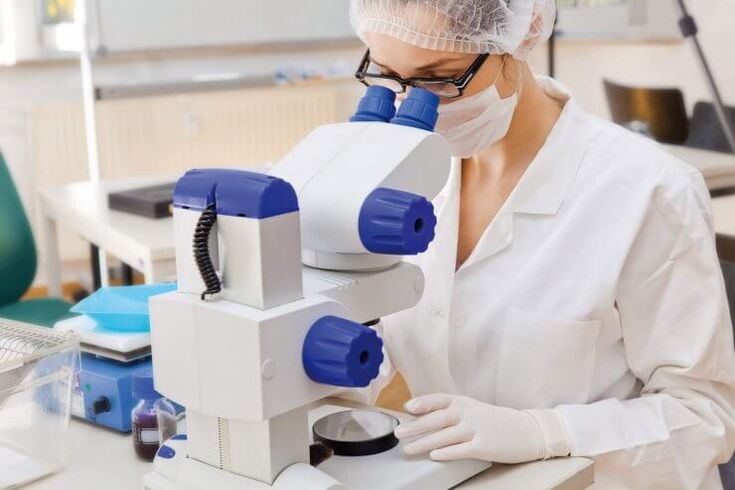Parasitic infections are called helminthiasis. This is a common and insidious disease that we can go years without knowing. The parasites enter the human intestine through dirty hands, food and water and begin to multiply actively.
They absorb nutrients, interrupt the absorption of water and vitamins in the intestines, cause diarrhea and disturb other internal organs. Therefore, it is very important to know what tests should be done for the parasites, in order to identify them in time and start the correct treatment.

Types of parasites and their diagnoses
Various types of worms can live in the human intestine: round, flat, ribbon. Any parasite is dangerous for the body as it releases toxic substances that affect the internal organs.
The consequences of helminthiasis can be very different, including death.
Everyone should know what tests need to be done for the parasites. The examination is performed both for the purpose of prevention and in the presence of characteristic symptoms. Do not postpone your visit to the doctor.
The danger of this condition is that symptoms do not always appear. For a long time, the person may not be aware of the presence of helminths, but at the same time there are slow and irreversible destructive processes in the organs. The infection pathways are very different: contact with an infected person or animal, through dirty hands, soil, food, water.
| Title | Infection paths | Symptoms | Analysis |
| Pinworms | Contamination by dirty hands | Itching in the anus, diarrhea, weight loss | Anal swab |
| Ascaris | Eating unwashed fruits and vegetables | Weakness, itchy anus, disturbed stools | Antibody blood test (ELISA) |
| Cat Fluke | Eating contaminated fish | Pain in the right side, allergic reactions, signs of liver damage | ELISA blood test |
| Triquinela | Eating contaminated meat and lard | Nausea, vomiting, diarrhea, allergic skin reactions, weakness | Antibody blood test |
| Intestinal acne | Any contact with contaminated soil | Diarrhea, nausea, vomiting, abdominal pain | Stool study for worm eggs, ELISA analysis |
Helminthiasis treatment is selected individually. Before prescribing any medication, the doctor will advise you to test and determine the exact type of parasite. Each individual helminth has a different effect on the body and leads to different complications. In theory, they can affect any organ, but are most often located in the intestines. The risk group includes young children and people working with the soil.

The main and dangerous signs of a parasitic infection
It can be difficult to recognize an infection. Symptoms are influenced not only by the type of helminths, but also by the age of the infected person, the state of their immune system and other characteristics of the body. Due to reduced immunity in children and the elderly, the clinical picture is more acute.
There are chronic helminthiasis that show no obvious signs and acute manifestations. They last for years and go unnoticed because the symptoms are blurred and easily mistaken for other chronic conditions.
See a doctor immediately and test for parasites when the following signs appear:
| Signs | Clinical presentation |
| Increased body temperature | This symptom does not always occur, but with severe damage to internal organs, the temperature can be high, reaching a fever. |
| Stool diseases | In helminthiasis, both constipation and diarrhea are observed. Various intestinal disorders can alternate, increase or disappear over time. In feces, mucus and blood impurities are often found. |
| Nausea and vomiting | Symptoms of intoxication appear in the acute form of the disease. These symptoms can be present with any parasite infestation. |
| Cough | In the prolonged course of the disease, helminths affect the bronchi and lungs. The patient develops a dry cough, which eventually turns to wet. |
| Allergy | The immune system starts to react to the parasites, then allergic reactions occur, usually skin reactions: itching, redness, hives. |
| Chronic fatigue | Helminthiasis causes weakness and fatigue, drowsiness due to intoxication of the body. |
| Weight loss | Due to impaired absorption in the intestine, a person loses weight even with the same diet. |
Regardless of which helminths have settled in the intestines, treatment should be started as soon as possible. Parasites cause intestinal inflammation, penetrate the lungs, gallbladder and even the heart. A preventive examination will help to avoid serious consequences and complications.
Preparation for blood and stool tests
The reliability of the result depends not only on the laboratory and the equipment, but also on compliance with the preparation rules. Violating these rules will lead to an incorrect result. The person may not notice the disease.
First of all, it is worth remembering that to assess the state it is necessary to choose proven clinics, reliable laboratories where certified specialists work. If the exam is done by a doctor, he warns about the preparation.
Preparation for stool analysis includes the following points:
- A few days before the stool is delivered, it is necessary to follow a light diet, not to eat spicy, fried, fast food and foods that cause flatulence. It is recommended to eat cereals, soups, dairy products with low fat content.
- If you can't go to the bathroom, you shouldn't do enemas or laxatives.
- It is not recommended to eat foods that color the feces: plums, tomatoes, beets, herbs.
- Before testing, you need to buy a sterile container with a special spatula. It is printed on the day of the test. Matchboxes cannot be used to collect material.
- The minimum amount of feces required for analysis is 15 g. If the quantity is less, the analysis must be repeated.
- Collect the material carefully so that urine or menstrual flow does not enter the stool.
- If the analysis shows the presence of helminths, after the end of the treatment course, the analysis must be repeated, observing all the rules above.
Preparation for donation is usually standard. You need to visit the laboratory on an empty stomach, do not eat fatty or spicy foods the day before. Any medication you take should be discussed with your doctor, as it may affect the parasite test result. It is recommended to stop drinking alcohol a week before donating blood. On the day of blood collection and the day before, you will not be able to attend physical therapy procedures, do an ultrasound. Smoking can also affect the outcome. It is advisable not to smoke for at least an hour before the exam.

Blood tests for parasites
A blood test for parasites is one of the most informative methods for diagnosing helminthiasis. There are several types of blood tests. The doctor prescribes one or more, depending on the clinical picture and anamnesis.
The advantage of a blood test over stool analysis for helminths is that eggs are not always found in the stool, you need to enter a certain breeding season for helminths. Blood can be donated at any time during the infection. Almost all laboratory tests are performed with special equipment and do not depend on the human factor. The ELISA allows you to determine not only worms, but also the degree of infection.
The doctor must be responsible for decoding the result. The most common are three blood tests to determine worms in the body:
| Method | Analysis resources |
| ELISA | ELISA is the most informative and reliable to determine a parasitic infection. The test is based on the antigen-antibody relationship. The result shows the presence or absence of a certain antibody in the blood, which indicates an acute or chronic stage of the disease. Thus, with parasitic lesions, IgG antibodies appear in the blood. The result is quite direct, positive or negative. However, it must be remembered that these antibodies appear both in chronic infections and during the recovery period. |
| PCR | The polymerase chain reaction also allows you to safely determine if there are parasites in the body. However, not all types of helminths are defined in this way, but only protozoa. The severity of the disease and the number of helminths cannot be determined in this way either. |
| UAC | This is a simple and quick diagnosis that gives you an idea of how the body is working as a whole. The presence of parasites can be suspected by the level of eosinophils, which will be increased. With helminthic invasions, the level of eosinophils exceeds 20% of the remaining leukocytes. In this case, additional examinations and determination of the type of parasite are prescribed. |

Stool parasite testing
The coprogram is a laboratory test for feces. It is prescribed if helminthiasis is suspected: faecal disorders, sudden weight loss, weakness, nausea, etc. You can do a coprogram in any laboratory: private or municipal.
The following indicators are taken into account when decoding:
| Metric | Decryption |
| Consistency and odor | The normal consistency is viscous without undigested pieces. |
| Color | Usually, the color is yellow or brown. Or it is too dark, this indicates the presence of hidden blood. Light colored stools indicate damage to the liver. |
| Weight | The presence of blood or mucus in the stool is taken into account. |
| Leukocytes | Leukocytes are normally present in faeces, but in minimal amounts. If there are many of them, then an inflammatory process has started in the intestines. |
| Acidity | The stool of a healthy person has a pH of 4, 8-5, 8. If the acidity increases, the absorption of fatty acids is impaired in the intestine. |
| Bilirubin | There is no bilirubin in the stool of a healthy person. Its presence indicates the presence of dysbiosis, increased peristalsis, rapid evacuation of feces. |
| Stercobilin | This enzyme can be present in faeces up to 350 mg / day. An increase indicates anemia, a decrease indicates damage to the gallbladder. |
Only a doctor can make a diagnosis based on such a result. More tests may be needed. For the result to be reliable, you need to collect and properly store the material. It is advisable to deliver it to the laboratory as soon as possible.
Scraping for enterobiasis
Scraping for enterobiasis is also an informative diagnosis. It is delivered according to instructions or for prevention. This is a painless procedure. Using a small spatula or cotton swab, remove some of the material from the anus. Just pass the toothpick several times to get the material.
Scraping is quite simple - worm eggs are absent or present. The disease is treatable, but if the result is positive, the patient is isolated to prevent further transmission of the infection.
























